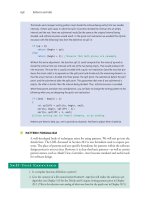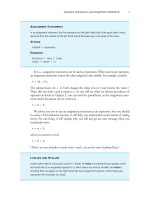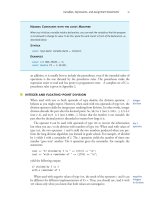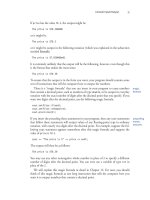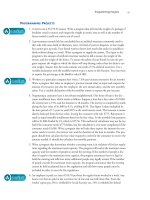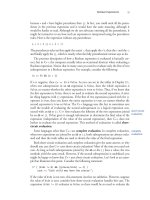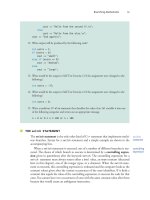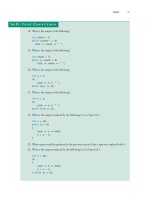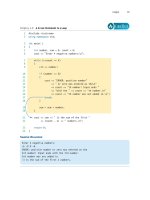Absolute C++ (4th Edition) part 8 docx
Bạn đang xem bản rút gọn của tài liệu. Xem và tải ngay bản đầy đủ của tài liệu tại đây (119.52 KB, 10 trang )
Loops 71
Self-Test Exercises
18. What is the output of the following?
int count = 3;
while (count > 0)
cout << count << " ";
19. What is the output of the following?
int count = 3;
while ( count > 0)
cout << count << " ";
20. What is the output of the following?
int n = 1;
do
cout << n << " ";
while (n++ <= 3);
21. What is the output of the following?
int n = 1;
do
cout << n << " ";
while (++n <= 3);
22. What is the output produced by the following? (x is of type int.)
int x = 10;
while (x > 0)
{
cout << x << endl;
x = x - 3;
}
23. What output would be produced in the previous exercise if the > sign were replaced with <?
24. What is the output produced by the following? (
x is of type int.)
int x = 10;
do
{
cout << x << endl;
x = x - 3;
} while (x > 0);
72 Flow of Control
25. What is the output produced by the following? (x is of type int.)
int x = -42;
do
{
cout << x << endl;
x = x - 3;
} while (x > 0);
26. What is the most important difference between a while statement and a do-while state-
ment?
■
THE COMMA OPERATOR
The comma operator is a way of evaluating a list of expressions and returning the
value of the last expression. It is sometimes handy to use in a
for loop, as indicated in
our discussion of the
for loop in the next subsection. We do not advise using it in other
contexts, but it is legal to use it in any expression.
The comma operator is illustrated by the following assignment statement:
result = (first = 2, second = first + 1);
The comma operator is the comma shown. The comma expression is the expression
on the right-hand side of the assignment operator. The comma operator has two
expressions as operands. In this case the two operands are
first = 2 and second = first + 1
The first expression is evaluated, and then the second expression is evaluated. As you
may recall from Chapter 1, the assignment statement when used as an expression
returns the new value of the variable on the left side of the assignment operator. So, this
comma expression returns the final value of the variable
second, which means that the
variable
result is set equal to 3.
Since only the value of the second expression is returned, the first expression is eval-
uated solely for its side effects. In the above example, the side effect of the first expres-
sion is to change the value of the variable
first.
You may have a longer list of expressions connected with commas, but you should
only do so when the order of evaluation is not important. If the order of evaluation is
important, you should use parentheses. For example:
result = ((first = 2, second = first + 1), third = second + 1);
comma
operator
Loops 73
sets the value of result equal to 4. However, the value that the following gives to
result is unpredictable, because it does not guarantee that the expressions are evalu-
ated in order:
result = (first = 2, second = first + 1, third = second + 1);
For example, third = second + 1 might be evaluated before second = first + 1.
1
■
THE
for
STATEMENT
The third and final loop statement in C++ is the for statement. The for statement is
most commonly used to step through some integer variable in equal increments. As we
will see in Chapter 5, the
for statement is often used to step through an array. The for
statement is, however, a completely general looping mechanism that can do anything
that a
while loop can do.
For example, the following
for statement sums the integers 1 through 10:
sum = 0;
for (n = 1; n <= 10; n++)
sum = sum + n;
A for statement begins with the keyword for followed by three things in parenthe-
ses that tell the computer what to do with the controlling variable. The beginning of a
for statement looks like the following:
for (
Initialization_Action
;
Boolean_Expression
;
Update_Action
)
The first expression tells how the variable, variables, or other things are initialized; the
second gives a Boolean expression that is used to check for when the loop should end;
and the last expression tells how the loop control variable is updated after each iteration
of the loop body.
The three expressions at the start of a
for statement are separated by two—and only
two—semicolons. Do not succumb to the temptation to place a semicolon after the
third expression. (The technical explanation is that these three things are expressions,
not statements, and so do not require a semicolon at the end.)
A
for statement often uses a single int variable to control loop iteration and loop
ending. However, the three expressions at the start of a
for statement may be any C++
expressions; therefore, they may involve more (or even fewer) than one variable, and
the variables may be of any type.
1
The C++ standard does specify that the expressions joined by commas should be evaluated left
to right. However, our experience has been that not all compilers conform to the standard in this
regard.
for
statement
74 Flow of Control
Using the comma operator, you can add multiple actions to either the first or the
last (but normally not the second) of the three items in parentheses. For example, you
can move the initialization of the variable
sum inside the for loop to obtain the follow-
ing, which is equivalent to the
for statement code we showed earlier:
for (sum = 0, n = 1; n <= 10; n++)
sum = sum + n;
Although we do not advise doing so because it is not as easy to read, you can move
the entire body of the
for loop into the third item in parentheses. The previous for
statement is equivalent to the following:
for (sum = 0, n = 1; n <= 10; sum = sum + n, n++);
Display 2.7 shows the syntax of a for statement and also describes the action of the
for statement by showing how it translates into an equivalent while statement. Notice
that in a
for statement, as in the corresponding while statement, the stopping condi-
tion is tested before the first loop iteration. Thus, it is possible to have a
for loop whose
body is executed zero times.
The body of a
for statement may be, and commonly is, a compound statement, as
in the following example:
for (number = 100; number >= 0; number )
{
cout << number
<< " bottles of beer on the shelf.\n";
if (number > 0)
cout << "Take one down and pass it around.\n";
}
The first and last expressions in parentheses at the start of a for statement may be any
C++ expression and thus may involve any number of variables and may be of any type.
In a
for statement, a variable may be declared at the same time as it is initialized.
For example:
for (int n = 1; n < 10; n++)
cout << n << endl;
Compilers may vary in how they handle such declarations within a for statement. This
is discussed in Chapter 3 in the subsection entitled “Variables Declared in a
for Loop”.
It might be wise to avoid such declarations within a
for statement until you reach
Chapter 3, but we mention it here for reference value.
Loops 75
Display 2.7 for Statement
for
S
TATEMENT
S
YNTAX
for (
Initialization_Action
;
Boolean_Expression
;
Update_Action
)
Body_Statement
E
XAMPLE
for (number = 100; number >= 0; number )
cout << number
<< " bottles of beer on the shelf.\n";
E
QUIVALENT
while
L
OOP
S
YNTAX
Initialization_Action
;
while (
Boolean_Expression
)
{
Body_Statement
Update_Action
;
}
E
QUIVALENT
E
XAMPLE
number = 100;
while (number >= 0)
{
cout << number
<< " bottles of beer on the shelf.\n";
number ;
}
S
AMPLE
D
IALOGUE
100 bottles of beer on the shelf.
99 bottles of beer on the shelf.
.
.
.
0 bottles of beer on the shelf.
76 Flow of Control
Pitfall
Problem semicolon
Tip
R
EPEAT
-
N
-T
IMES
L
OOPS
A for statement can be used to produce a loop that repeats the loop body a predetermined num-
ber of times. For example, the following is a loop body that repeats its loop body three times:
for (int count = 1; count <= 3; count++)
cout << "Hip, Hip, Hurray\n";
The body of a for statement need not make any reference to a loop control variable, such as the
variable
count.
E
XTRA
S
EMICOLON
IN
A
for
S
TATEMENT
You normally do not place a semicolon after the parentheses at the beginning of a for loop. To
see what can happen, consider the following
for loop:
for (int count = 1; count <= 10; count++);
cout << "Hello\n";
If you did not notice the extra semicolon, you might expect this for loop to write Hello to the
screen ten times. If you do notice the semicolon, you might expect the compiler to issue an error
message. Neither of those things happens. If you embed this
for loop in a complete program, the
compiler will not complain. If you run the program, only one
Hello will be output instead of ten
Hellos. What is happening? To answer that question, we need a little background.
One way to create a statement in C++ is to put a semicolon after something. If you put a semicolon
after x++, you change the expression
x++
for
S
TATEMENT
S
YNTAX
for (
Initialization_Action
;
Boolean_Expression
;
Update_Action
)
Body_Statement
E
XAMPLE
for (sum = 0, n = 1; n <= 10; n++)
sum = sum + n;
See Display 2.7 for an explanation of the action of a for statement.
Loops 77
Pitfall
into the statement
x++;
If you place a semicolon after nothing, you still create a statement. Thus, the semicolon by itself is
a statement, which is called the ee
ee
mm
mm
pp
pp
tt
tt
yy
yy
ss
ss
tt
tt
aa
aa
tt
tt
ee
ee
mm
mm
ee
ee
nn
nn
tt
tt
or the nn
nn
uu
uu
ll
ll
ll
ll
ss
ss
tt
tt
aa
aa
tt
tt
ee
ee
mm
mm
ee
ee
nn
nn
tt
tt
. The empty statement per-
forms no action, but it still is a statement. Therefore, the following is a complete and legitimate
for loop, whose body is the empty statement:
for (int count = 1; count <= 10; count++);
This for loop is indeed iterated ten times, but since the body is the empty statement, nothing
happens when the body is iterated. This loop does nothing, and it does nothing ten times!
This same sort of problem can arise with a while loop. Be careful not to place a semicolon after
the closing parenthesis that encloses the Boolean expression at the start of a
while loop. A do-
while
loop has just the opposite problem. You must remember always to end a do-while loop
with a semicolon.
I
NFINITE
L
OOPS
A while loop, do-while loop, or for loop does not terminate as long as the controlling Boolean
expression is true. This Boolean expression normally contains a variable that will be changed by
the loop body, and usually the value of this variable is changed in a way that eventually makes
the Boolean expression false and therefore terminates the loop. However, if you make a mistake
and write your program so that the Boolean expression is always true, then the loop will run for-
ever. A loop that runs forever is called an ii
ii
nn
nn
ff
ff
ii
ii
nn
nn
ii
ii
tt
tt
ee
ee
ll
ll
oo
oo
oo
oo
pp
pp
.
Unfortunately, examples of infinite loops are not hard to come by. First let’s describe a loop that
does terminate. The following C++ code will write out the positive even numbers less than
12. That
is, it will output the numbers
2, 4, 6, 8, and 10, one per line, and then the loop will end.
x = 2;
while (x != 12)
{
cout << x << endl;
x = x + 2;
}
The value of x is increased by 2 on each loop iteration until it reaches 12. At that point, the Bool-
ean expression after the word
while is no longer true, so the loop ends.
Now suppose you want to write out the odd numbers less than 12, rather than the even numbers.
You might mistakenly think that all you need do is change the initializing statement to
x = 1;
empty
statement
infinite
loop
78 Flow of Control
Self-Test Exercises
But this mistake will create an infinite loop. Because the value of x goes from 11 to 13, the value
of
x is never equal to 12; thus, the loop will never terminate.
This sort of problem is common when loops are terminated by checking a numeric quantity using
== or !=. When dealing with numbers, it is always safer to test for passing a value. For example,
the following will work fine as the first line of our
while loop:
while (x < 12)
With this change, x can be initialized to any number and the loop will still terminate.
A program that is in an infinite loop will run forever unless some external force stops it. Since you
can now write programs that contain an infinite loop, it is a good idea to learn how to force a pro-
gram to terminate. The method for forcing a program to stop varies from system to system. The
keystrokes Control-C will terminate a program on many systems. (To type Control-C, hold down
the Control key while pressing the C key.)
In simple programs, an infinite loop is almost always an error. However, some programs are
intentionally written to run forever (in principle), such as the main outer loop in an airline reser-
vation program, which just keeps asking for more reservations until you shut down the computer
(or otherwise terminate the program in an atypical way).
27. What is the output of the following (when embedded in a complete program)?
for (int count = 1; count < 5; count++)
cout << (2 * count) << " ";
28. What is the output of the following (when embedded in a complete program)?
for (int n = 10; n > 0; n = n - 2)
{
cout << "Hello ";
cout << n << endl;
}
29. What is the output of the following (when embedded in a complete program)?
for (double sample = 2; sample > 0; sample = sample - 0.5)
cout << sample << " ";
30. Rewrite the following loops as for loops.
a.
int i = 1;
while(i <= 10)
{
Loops 79
if (i < 5 && i != 2)
cout << ‘X’;
i++;
}
b.
int i = 1;
while(i <=10)
{
cout << ‘X’;
i = i + 3;
}
c.
long n = 100;
do
{
cout << ‘X’;
n = n + 100;
} while(n < 1000);
31. What is the output of this loop? Identify the connection between the value of n and the
value of the variable
log.
int n = 1024;
int log = 0;
for (int i = 1; i < n; i = i * 2)
log++;
cout << n << " " << log << endl;
32. What is the output of this loop? Comment on the code. (This is not the same as the previ-
ous exercise.)
int n = 1024;
int log = 0;
for (int i = 1; i < n; i = i * 2);
log++;
cout << n << " " << log << endl;
33. What is the output of this loop? Comment on the code. (This is not the same as either of
the two previous exercises.)
int n = 1024;
int log = 0;
for (int i = 0; i < n; i = i * 2);
log++;
cout << n << " " << log << endl;
80 Flow of Control
34. For each of the following situations, tell which type of loop (while, do-while, or for)
would work best.
a. Summing a series, such as
1/2 + 1/3 + 1/4 + 1/5 + . . . + 1/10.
b. Reading in the list of exam scores for one student.
c. Reading in the number of days of sick leave taken by employees in a department.
d. Testing a function to see how it performs for different values of its arguments.
35. What is the output produced by the following? (
x is of type int.)
int x = 10;
while (x > 0)
{
cout << x << endl;
x = x + 3;
}
■
THE
break
AND
continue
STATEMENTS
In previous subsections, we have described the basic flow of control for the while, do-
while
, and for loops. This is how the loops should normally be used and is the way
they are usually used. However, you can alter the flow of control in two ways, which in
rare cases can be a useful and safe technique. The two ways of altering the flow of con-
trol are to insert a
break or continue statement. The break statement ends the loop.
The
continue statement ends the current iteration of the loop body. The break state-
ment can be used with any of the C++ loop statements.
We described the
break statement when we discussed the switch statement. The
break statement consists of the keyword break followed by a semicolon. When exe-
cuted, the
break statement ends the nearest enclosing switch or loop statement. Dis-
play 2.8 contains an example of a
break statement that ends a loop when inappropriate
input is entered.
The
continue statement consists of the keyword continue followed by a semicolon.
When executed, the
continue statement ends the current loop body iteration of the
nearest enclosing
loop statement. Display 2.9 contains an example of a loop that con-
tains a
continue statement.
One point that you should note when using the
continue statement in a for loop is
that the
continue statement transfers control to the update expression. So, any loop
control variable will be updated immediately after the
continue statement is executed.
Note that a
break statement completely ends the loop. In contrast, a continue
statement merely ends one loop iteration; the next iteration (if any) continues the loop.
You will find it instructive to compare the details of the programs in Displays 2.8 and
2.9. Pay particular attention to the change in the controlling Boolean expression.
continue
statement
